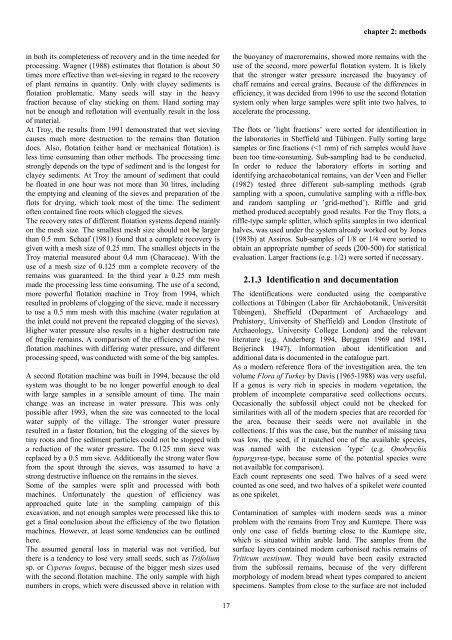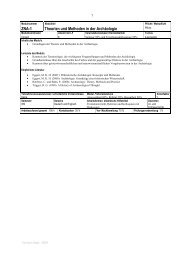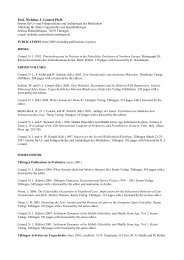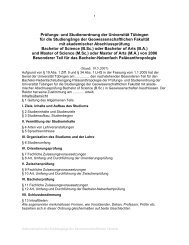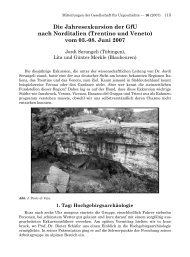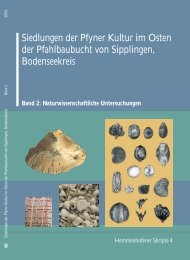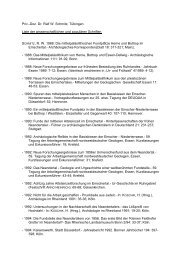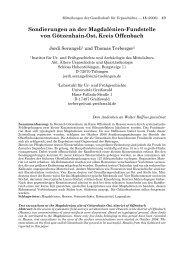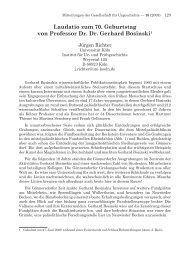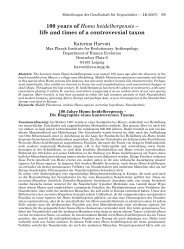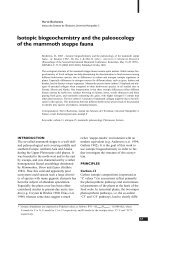bronze age environment and economy in the troad - Universität ...
bronze age environment and economy in the troad - Universität ...
bronze age environment and economy in the troad - Universität ...
You also want an ePaper? Increase the reach of your titles
YUMPU automatically turns print PDFs into web optimized ePapers that Google loves.
chapter 2: methods<br />
<strong>in</strong> both its completeness of recovery <strong>and</strong> <strong>in</strong> <strong>the</strong> time needed for<br />
process<strong>in</strong>g. Wagner (1988) estimates that flotation is about 50<br />
times more effective than wet-siev<strong>in</strong>g <strong>in</strong> regard to <strong>the</strong> recovery<br />
of plant rema<strong>in</strong>s <strong>in</strong> quantity. Only with clayey sediments is<br />
flotation problematic. Many seeds will stay <strong>in</strong> <strong>the</strong> heavy<br />
fraction because of clay stick<strong>in</strong>g on <strong>the</strong>m. H<strong>and</strong> sort<strong>in</strong>g may<br />
not be enough <strong>and</strong> reflotation will eventually result <strong>in</strong> <strong>the</strong> loss<br />
of material.<br />
At Troy, <strong>the</strong> results from 1991 demonstrated that wet siev<strong>in</strong>g<br />
causes much more destruction to <strong>the</strong> rema<strong>in</strong>s than flotation<br />
does. Also, flotation (ei<strong>the</strong>r h<strong>and</strong> or mechanical flotation) is<br />
less time consum<strong>in</strong>g than o<strong>the</strong>r methods. The process<strong>in</strong>g time<br />
strongly depends on <strong>the</strong> type of sediment <strong>and</strong> is <strong>the</strong> longest for<br />
clayey sediments. At Troy <strong>the</strong> amount of sediment that could<br />
be floated <strong>in</strong> one hour was not more than 30 litres, <strong>in</strong>clud<strong>in</strong>g<br />
<strong>the</strong> empty<strong>in</strong>g <strong>and</strong> clean<strong>in</strong>g of <strong>the</strong> sieves <strong>and</strong> preparation of <strong>the</strong><br />
flots for dry<strong>in</strong>g, which took most of <strong>the</strong> time. The sediment<br />
often conta<strong>in</strong>ed f<strong>in</strong>e roots which clogged <strong>the</strong> sieves.<br />
The recovery rates of different flotation systems depend ma<strong>in</strong>ly<br />
on <strong>the</strong> mesh size. The smallest mesh size should not be larger<br />
than 0.5 mm. Schaaf (1981) found that a complete recovery is<br />
given with a mesh size of 0.25 mm. The smallest objects <strong>in</strong> <strong>the</strong><br />
Troy material measured about 0.4 mm (Characeae). With <strong>the</strong><br />
use of a mesh size of 0.125 mm a complete recovery of <strong>the</strong><br />
rema<strong>in</strong>s was guaranteed. In <strong>the</strong> third year a 0.25 mm mesh<br />
made <strong>the</strong> process<strong>in</strong>g less time consum<strong>in</strong>g. The use of a second,<br />
more powerful flotation mach<strong>in</strong>e <strong>in</strong> Troy from 1994, which<br />
resulted <strong>in</strong> problems of clogg<strong>in</strong>g of <strong>the</strong> sieve, made it necessary<br />
to use a 0.5 mm mesh with this mach<strong>in</strong>e (water regulation at<br />
<strong>the</strong> <strong>in</strong>let could not prevent <strong>the</strong> repeated clogg<strong>in</strong>g of <strong>the</strong> sieves).<br />
Higher water pressure also results <strong>in</strong> a higher destruction rate<br />
of fragile rema<strong>in</strong>s. A comparison of <strong>the</strong> efficiency of <strong>the</strong> two<br />
flotation mach<strong>in</strong>es with differ<strong>in</strong>g water pressure, <strong>and</strong> different<br />
process<strong>in</strong>g speed, was conducted with some of <strong>the</strong> big samples.<br />
A second flotation mach<strong>in</strong>e was built <strong>in</strong> 1994, because <strong>the</strong> old<br />
system was thought to be no longer powerful enough to deal<br />
with large samples <strong>in</strong> a sensible amount of time. The ma<strong>in</strong><br />
change was an <strong>in</strong>crease <strong>in</strong> water pressure. This was only<br />
possible after 1993, when <strong>the</strong> site was connected to <strong>the</strong> local<br />
water supply of <strong>the</strong> vill<strong>age</strong>. The stronger water pressure<br />
resulted <strong>in</strong> a faster flotation, but <strong>the</strong> clogg<strong>in</strong>g of <strong>the</strong> sieves by<br />
t<strong>in</strong>y roots <strong>and</strong> f<strong>in</strong>e sediment particles could not be stopped with<br />
a reduction of <strong>the</strong> water pressure. The 0.125 mm sieve was<br />
replaced by a 0.5 mm sieve. Additionally <strong>the</strong> strong water flow<br />
from <strong>the</strong> spout through <strong>the</strong> sieves, was assumed to have a<br />
strong destructive <strong>in</strong>fluence on <strong>the</strong> rema<strong>in</strong>s <strong>in</strong> <strong>the</strong> sieves.<br />
Some of <strong>the</strong> samples were split <strong>and</strong> processed with both<br />
mach<strong>in</strong>es. Unfortunately <strong>the</strong> question of efficiency was<br />
approached quite late <strong>in</strong> <strong>the</strong> sampl<strong>in</strong>g campaign of this<br />
excavation, <strong>and</strong> not enough samples were processed like this to<br />
get a f<strong>in</strong>al conclusion about <strong>the</strong> efficiency of <strong>the</strong> two flotation<br />
mach<strong>in</strong>es. However, at least some tendencies can be outl<strong>in</strong>ed<br />
here.<br />
The assumed general loss <strong>in</strong> material was not verified, but<br />
<strong>the</strong>re is a tendency to lose very small seeds, such as Trifolium<br />
sp. or Cyperus longus, because of <strong>the</strong> bigger mesh sizes used<br />
with <strong>the</strong> second flotation mach<strong>in</strong>e. The only sample with high<br />
numbers <strong>in</strong> crops, which were discussed above <strong>in</strong> relation with<br />
<strong>the</strong> buoyancy of macrorema<strong>in</strong>s, showed more rema<strong>in</strong>s with <strong>the</strong><br />
use of <strong>the</strong> second, more powerful flotation system. It is likely<br />
that <strong>the</strong> stronger water pressure <strong>in</strong>creased <strong>the</strong> buoyancy of<br />
chaff rema<strong>in</strong>s <strong>and</strong> cereal gra<strong>in</strong>s. Because of <strong>the</strong> differences <strong>in</strong><br />
efficiency, it was decided from 1996 to use <strong>the</strong> second flotation<br />
system only when large samples were split <strong>in</strong>to two halves, to<br />
accelerate <strong>the</strong> process<strong>in</strong>g.<br />
The flots or ‛light fractions’ were sorted for identification <strong>in</strong><br />
<strong>the</strong> laboratories <strong>in</strong> Sheffield <strong>and</strong> Tüb<strong>in</strong>gen. Fully sort<strong>in</strong>g large<br />
samples or f<strong>in</strong>e fractions (


